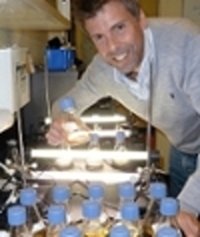News & Events
MSC03 2060
300 Terrace St. NE
Albuquerque, NM 87131-0001
Physical Location:
Clark Hall
Phone: 505-277-6655
chemistry@unm.edu
MSC03 2060
300 Terrace St. NE
Albuquerque, NM 87131-0001
Physical Location:
Clark Hall
Phone: 505-277-6655
chemistry@unm.edu

Profile: Dr. Gregory D. Scholes received his B.Sc. in Chemistry in 1990 and his Ph.D. in Physical Chemistry in 1994 from the University of Melbourne. Presently, Dr. Scholes is the William S. Tod Professor of Chemistry and the Principle Investigator for the Scholes Group at Princeton University, Princeton, NJ. Dr. Scholes is an expert on electronic energy transfer and molecular excitons. Current research in the Scholes Group concerns design principles and paradigms for directing and regulating light-initiated energy flow in man-made and natural systems, like proteins involved in photosynthesis. A goal is to learn new ways to harness the power of light in chemistry. The Scholes Group combines ultrafast laser spectroscopies—methods such as 2D electronic spectroscopy—with theoretical studies to understand mechanisms of light harvesting, electron transfer, and other photo-initiated processes. In 2010, the group reported that fragile quantum mechanical processes are detected even at physiological temperature in the primary light-harvesting proteins of algae. This work inspired new research in areas ranging from theoretical quantum physics to chemical dynamics to biology and has been highlighted in magazines including New Scientist (2010, 2011), Wired (2010, 2011), Scientific American (2009, 2010), Science News (2010, 2011), Nature (2011), Focus (2012), Cosmos (2014); national radio (e.g. CBC Quirks and Quarks and BBC Science in Action); and television documentaries such as Invisible Nature (Discovery Channel). Recent work includes development of more revealing metrics for exciton size (delocalization) and several experimental studies of vibrational wavepackets; how they can be characterized, and what they can tell us about electronically coupled molecules and dynamics. Some of Dr. Scholes honors include: the Masuhara Lectureship Award, Asian Photochemical Conference (2016), Beijing Institute of Technology Adjunct Professor, China (2016), Honorary Professor at Central South University, China (2017), the Swiss Chemical Society Lectureship (2016), Senior Fellow, CIFAR Biology, Energy, Technology Program (2015), Fellow, Royal Society of Chemistry (United Kingdom), the NSERC John C. Polanyi Award (2013), the Royal Society of Chemistry Bourke Award (2012), the Raymond and Beverly Sackler Prize in Physical Sciences (Tel Aviv University) [2011], the Royal Society of Canada Rutherford Memorial Medal in Chemistry (2007), the Chemical Institute of Canada Keith Laidler Award (2006), the Research Innovation Award (Research Corporation) [2002], and the Premier’s Research Excellence Award (2000). For more information on Dr. Scholes check out his group’s website.

Abstract: Coherence phenomena arise from interference, or the addition, of wave-like amplitudes in phase [1]. While coherence has been shown to yield transformative new ways for improving function, advances have been limited to pristine matter, as quantum coherence is considered fragile. Here I will discuss how vibrational and vibronic wavepackets entrain ensembles of molecules, like the synchronized flashing of fireflies. I will discuss how this can be used to probe mechanisms of ultrafast dynamics and how in-step vibrational motion might be employed to control function on ultrafast timescales. I will give examples that include light-harvesting in photosynthesis, energy flow in organometallic molecules that is ‘wired’ by Fermi resonance, and ultrafast electron transfer in molecular systems. Coherence phenomena arise from interference, or the addition, of wave-like amplitudes in phase [1]. While coherence has been shown to yield transformative new ways for improving function, advances have been limited to pristine matter, as quantum coherence is considered fragile. Here I will discuss how vibrational and vibronic wavepackets entrain ensembles of molecules, like the synchronized flashing of fireflies. I will discuss how this can be used to probe mechanisms of ultrafast dynamics and how in-step vibrational motion might be employed to control function on ultrafast timescales. I will give examples that include light-harvesting in photosynthesis, energy flow in organometallic molecules that is ‘wired’ by Fermi resonance, and ultrafast electron transfer in molecular systems.
[1] Scholes, et al. “Optimal Coherence in Chemical and Biophysical Dynamics” Nature 543, 647–656 (2017).See Announcement